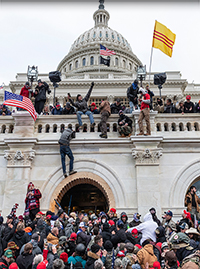| Finally, the Facts About a Capitol Riot Casualty |
 |
|
By Byron York
Wednesday, April 21 2021 |
It took nearly 3 1/2 months for the District of Columbia medical examiner's office to announce a cause of death for Capitol Police Officer Brian Sicknick, who helped defend the Capitol during the Jan. 6 riot and died the next day in a local hospital. The medical examiner ruled that Sicknick died of natural causes, specifically, after suffering two strokes. Medical examiner Francisco Diaz did not publicly release his report on Sicknick's death. Instead, much of the public's information comes from an interview Diaz gave to The Washington Post. Diaz told the paper that the autopsy "found no evidence the 42-year-old officer suffered an allergic reaction to chemical irritants, which Diaz said would have caused Sicknick's throat to quickly seize. Diaz also said there was no evidence of internal or external injuries." So Sicknick did not die from the rioters striking him with a fire extinguisher or any other object, as originally reported. Nor did he die from being hit by bear spray, as was theorized after the fire extinguisher explanation fell apart. Diaz also gave the Post a new timeline for the events leading up to Sicknick's death. "Sicknick collapsed seven hours and 40 minutes after he was sprayed, and then died nearly 24 hours after that," the medical examiner said. According to the federal indictment of two rioters charged in Sicknick's death, the officer was hit by bear spray at 2:23 p.m. on Jan. 6. That would mean he collapsed around 10 p.m. that night, and died around the same time the next night, Jan. 7. There are still things the public does not know about the case. It is simply not clear what role, if any, Sicknick's participation in the fight to defend the Capitol played in his death. Diaz said "all that transpired played a role in his condition." But what role? And at the same time, Diaz "said he could not comment on whether Sicknick had a preexisting medical condition, citing privacy laws." So exactly how the riot might have contributed to Sicknick's death is not clear. But finally, Americans know the basic facts of Sicknick's death. And that means a number of media organizations have a lot of explaining to do. First among them is The New York Times, which on Jan. 8 – shortly after Sicknick's death – reported, "Pro-Trump supporters ... overpowered Mr. Sicknick, 42, and struck him in the head with a fire extinguisher, according to two law enforcement officials. With a bloody gash in his head, Mr. Sicknick was rushed to the hospital and placed on life support. He died on Thursday [Jan. 7] evening." The Times' wrong report stirred enormous emotion among millions of Americans already upset about the Capitol riot. Newscasts on CNN, MSNBC and the broadcast networks repeated the Times report frequently and uncritically. Some commentators went around the bend. When Republican Sen. Mike Lee suggested President Trump should get a "mulligan" for the speech he gave at the Ellipse on Jan. 6, MSNBC's Joe Scarborough responded, "You don't get a mulligan when you kill a cop, Mike. When you ... bash police officers' brains with fire extinguishers, you don't get a mulligan. Especially if you're the one responsible for bringing those cop killers up to Capitol Hill." The entire tirade was based on a false account of Officer Sicknick's death. The bottom line is that false account became an integral part of the national conversation about the Capitol riot. Now, the damage from that false account cannot be undone. But the news organizations and commentators who fed the frenzy should report the medical examiner's findings and their implications prominently and accurately – and tell viewers and readers that they had it wrong. Byron York is chief political correspondent for The Washington Examiner.
|
Related Articles : |
























